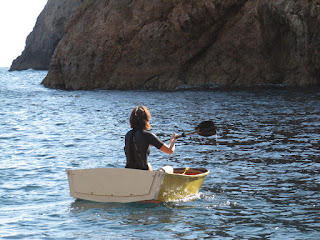Koan's cabin sole was upholstered in a non-skid patterned vinyl that was dirty and disgusting. I'd seen photos of other IFboats with that removed and I was really aching to get it off mine.
The removal of the vinyl lining from the insides of the hull and the plywood floor boards was annoying enough as it was. But it turned out a huge challenge lay further ahead. The vinyl had been glued on with a disgusting green glue that was resistant to most everything I tried on it. Three glue removers did nothing, and acetone worked, but required huge amounts. Finally, a couple months after avoiding the subject, I decided to try Franmar's Soy Strip. This is the stripper that saved my ass when I re-did Shadow Line's deck back in 2007-2008, and I should've thought of it earlier, except that it's intended for much much more tenacious things, like anti-fouling paint. In any case, Franmar to the rescue! A couple days later I had the majority of the green glue off, and I wasn't the worse for exposure to VOCs, since Soy Strip can be handled without much protection. In the process I did accidentally get some of the stripper on other wooden surfaces in the boat, so some of those will need to be stripped and re-varnished, but one could argue that needed to be done anyway.
I wrapped the floor boards in a natural cork liner that I don't think is going to hold up too well. But there wasn't much choice, as they were completely coated in the disgusting green stuff. I didn't reinstall the holes for the table or the tabs for pulling up the floor boards, since those are all superfluous. Now I just need to go over the hull sections and remove the remaining bits of glue with acetone and a towel...
The removal of the vinyl lining from the insides of the hull and the plywood floor boards was annoying enough as it was. But it turned out a huge challenge lay further ahead. The vinyl had been glued on with a disgusting green glue that was resistant to most everything I tried on it. Three glue removers did nothing, and acetone worked, but required huge amounts. Finally, a couple months after avoiding the subject, I decided to try Franmar's Soy Strip. This is the stripper that saved my ass when I re-did Shadow Line's deck back in 2007-2008, and I should've thought of it earlier, except that it's intended for much much more tenacious things, like anti-fouling paint. In any case, Franmar to the rescue! A couple days later I had the majority of the green glue off, and I wasn't the worse for exposure to VOCs, since Soy Strip can be handled without much protection. In the process I did accidentally get some of the stripper on other wooden surfaces in the boat, so some of those will need to be stripped and re-varnished, but one could argue that needed to be done anyway.
I wrapped the floor boards in a natural cork liner that I don't think is going to hold up too well. But there wasn't much choice, as they were completely coated in the disgusting green stuff. I didn't reinstall the holes for the table or the tabs for pulling up the floor boards, since those are all superfluous. Now I just need to go over the hull sections and remove the remaining bits of glue with acetone and a towel...































